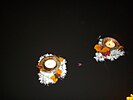Diya (lamp)
This article needs additional citations for verification. (September 2015) |
Diya, or oil lamp, in different formations | |||||||
A Diya, diyo, deya,[1] divaa, deepa, deepam, or deepak is an oil lamp used in the Indian subcontinent, notably India and Nepal, usually made from clay, with a cotton wick dipped in ghee or vegetable oils. Diyas are native to the Indian subcontinent often used in Hindu, Sikh, Jain and Zoroastrian religious festivals such as Diwali[2] or the Kushti ceremony.
Traditional use
Clay diyas are often used temporarily as lighting for special occasions, while diyas made of brass are permanent fixtures in homes and temples.
Festivals
Diwali: The lightening of Diyas forms an important part of celebrations and rituals of the festival. The houses are decorated with small diyas being placed at boundaries and entrance of houses.[3] In fact, the name of Diwali is derived from the Sanskrit word Deepavali, which means the row of lights ("deep" means Diya and "avali" means row).[4]
Karthikai Deepam: Diyas, also known as deepam in Tamil Nadu, can be lighted, especially during the Karthikai Deepam.
Worship and prayers
A diya placed in temples and used to bless worshippers is referred to as an aarti.
A similar lamp called a butter lamp is used in Tibetan Buddhist offerings as well.
Hindu Rituals
Death: The lighting of diya is also part of the Hindu religion rituals related to death.[5][6] [7]
See also
References
- ^ Sacred Places of a Lifetime. Washington DC: National Geographic Society. 2008. p. 270. ISBN 978-1-4262-0336-7.
- ^ "Diwali: Significance of a Diya". Zee Media Corporation Ltd. Retrieved 19 July 2013.
- ^ The Asiatic Journal and Monthly Register for British and Foreign India, China, and Australia Front Cover Parbury, Allen, and Company, 1834, page 346
- ^ Tej K. Bhatia and Naresh Sharma "The Routledge Intermediate Hindi Reader", Routledge, 2015 ISBN 1317962850, 9781317962854
- ^ "Rituals after death as per Hinduism". Hindu Janajagruti Samiti. Retrieved 25 April 2018.
- ^ "Introduction to death & dying". srimatham.com. Retrieved 25 April 2018.
- ^ "Hindu Death Rites". Asian Cremation USA. Retrieved 25 April 2018.






